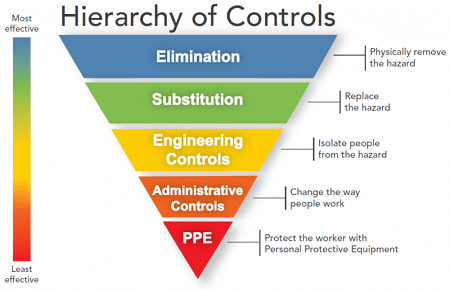Workplace safety is of the utmost importance to ensure that employees are protected from hazards and injury. One effective way to reduce risk and increase safety in the workplace is through the use of the hierarchy of controls. This system, developed by the National Institute for Occupational Safety and Health (NIOSH), prioritizes different strategies for controlling hazards and is widely used in occupational health and safety management.
The Hierarchy of Hazard Control is a widely accepted and promoted system used in businesses to reduce or remove exposure to potentially dangerous conditions. This hierarchical model is typically represented using a triangle, with Elimination at the top – the most effective form of hazard management – followed by Substitution, Engineering controls, Administrative controls, and Personal Protective Equipment (in descending order). Implementing this framework can ensure that your workplace remains safe for everyone involved. As the most successful hazard control measure, Elimination entails physically eliminating any hazardous elements. Substituting something that produces a hazard with another that does not produce it or creates less risk is also an option. To separate people from hazards, Engineering Controls can be helpful, while Administrative Controls alter how individuals work to reduce their exposure to potential risks. Last but not least is Personal Protective Equipment such as gloves, Nomex clothing pieces, respirators, hard hats, and safety glasses, which provide added protection against danger.
In this article, we will discuss how to apply the hierarchy of controls to keep workers safe in the workplace.
- Identifying hazards: The first step in applying the hierarchy of controls is to identify the hazards present in the workplace. This includes assessing the potential risks and determining the likelihood and severity of injury or harm. Employers should conduct regular risk assessments and involve employees in the process. This can help to identify hazards that may not be immediately obvious and can also help to ensure that employees are aware of the hazards in their work environment. It is important to identify the hazards and prioritize them based on the likelihood and the severity of the harm it can cause.
- Elimination: The most effective control is elimination. This includes eliminating the hazard altogether by removing the source of the hazard or replacing it with a safer alternative. For example, replacing a dangerous chemical with a safer alternative or eliminating a hazardous process altogether. Elimination is the first step in the hierarchy of controls because it completely removes the hazard from the workplace, thus reducing the risk of injury or harm to employees. Employers should identify ways to eliminate hazards and implement them as soon as possible.
- Engineering controls: When elimination is not feasible, the next step is to use engineering controls. This includes designing or modifying equipment or processes to reduce the risk of injury. For example, installing guards or barriers to protect workers from moving machinery or using ventilation systems to reduce exposure to harmful chemicals. Engineering controls are effective in reducing the risk of injury or harm by separating the worker from the hazard. Employers should identify ways to implement engineering controls and ensure that they are properly maintained and used.
- Administrative controls and PPE: Administrative controls include policies, procedures, and training programs that help to reduce the risk of injury. For example, implementing safety procedures or providing training on safe work practices. PPE, such as protective clothing and equipment, is the last line of defense against hazards and should only be used when other controls are not feasible or adequate. Employers should ensure that their employees are provided with the proper PPE and are trained on how to use it properly.
- Evaluate and monitor the effectiveness of the controls: The final step in applying the hierarchy of controls is to evaluate and monitor the effectiveness of the controls in place. Regularly conducting safety audits and inspections, and tracking incidents and near-misses can help to identify any areas where improvements are needed. It is also important to periodically review the controls in place to ensure they remain effective and to implement new controls as necessary. For example, if a safety audit reveals that a guard on a machine is not properly secured, the employer should take steps to fix the guard immediately. Additionally, employers should involve employees in monitoring the effectiveness of controls, as they are often the ones who are most familiar with the hazards and the controls in place.
In conclusion, the hierarchy of controls is a powerful tool for reducing risk and increasing safety in the workplace. By identifying hazards, eliminating them when possible, implementing engineering controls, administrative controls and providing PPE, employers can create a safer working environment for their employees. Regularly evaluating and monitoring the effectiveness of controls is crucial to ensure that they remain effective and that new hazards are identified and controlled as soon as possible. Remember that the goal of workplace safety is to eliminate hazards and if that’s not possible to control them as much as possible.










